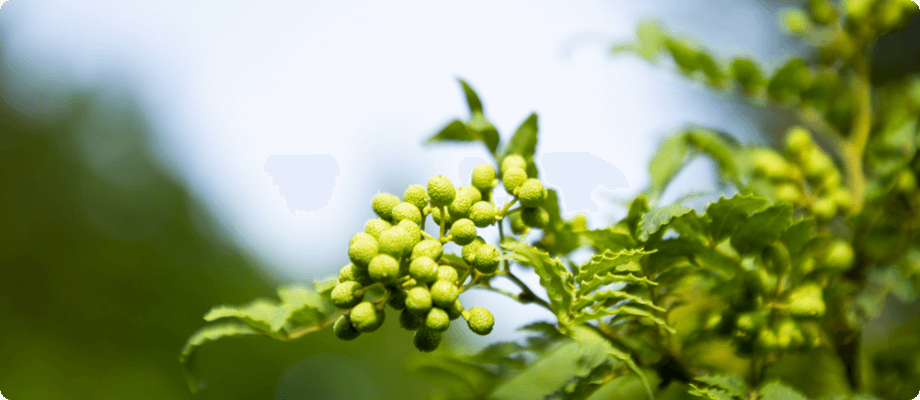Simulation model
○ Mizansho 3 people
x 8 days
○ Dried Sansho 1 person
x 10 days
20 ares = 2,000 square meters

The basic harvest of Budo sansho farmers in Aridagawa is mizansho and dried sansho. As cultivation and harvesting techniques improve, the production volume will stabilize and the profitability will increase. Sansho is a dioecious plant, which means that the pollen from the flowers on the male tree is pollinated by the flowers on the female tree to produce fruit. Therefore, for every 10 female trees planted for pollination, one male tree is planted, and a typical planting area requires 70 to 80 trees per 10 ares of farmland.
Weeding, fertilizing, spraying organic agrochemicals, pruning, and other important work is done outside of the harvesting season, but other than the harvesting of the mizansho, which is done for about 10 days in mid to late May, and the dried sansho from early July to mid-August, it is generally not very busy. The peak season lasts only about 60 days in a year, so it is easy to find a good balance between growing sansho as well as balancing with other work, and have the freedom to find time for personal life, hobbies, and family.
Sansho farmers in Aridagawa established the "Shimizusansho Production Cooperative" in 1968 with the aim to ensure stabilized production and quality improvement. They have been striving to share cultivation techniques and to consolidate and improve quality at each stage of cultivation, harvesting, drying, and shipping.
As a result of these community-wide efforts, Aridagawa's Budo sansho has come to be highly regarded. In the mountainous areas where the population is aging, Budo sansho has become an important industry to support the region.

Target estimate of production revenue
| Item | Yield (kg) | Taraget Profit |
|---|---|---|
| Mizansho | 200 | 568,000 (yen) |
| Dried Sansho | 400 | 592,000 (yen) |
| Total | 1,160,000 (yen) |
Specific revenue estimates (Aridagawa town survey)
| Mizansho | |
|---|---|
| Target Yield (kg) | 400 |
| Unit Sales Price (yen/kg) | 2,600 |
| Gross Revenue (yen) | 1,040,000 |
| Fertilizer and Organic Agrochemical Expenses | 92,000 |
| Shipping Expenses | 380,000 |
| Total Expenses | 472,000 |
| Net Revenue | 568,000 (yen) |
| Income Ratio (%) | 54.6% |
- 〇Unit sales price is the average unit price for 2018-2020.
- 〇Shipping expenses include materials such as packaging, shipping, taxes, hiring during the harvest season, freight, etc.
- 〇For the rates for hired labor, we assume that 3 people are hired for 8 days during the peak harvest season in May.
@8,000 yen x 3 people x 8 days = 192,000 yen

| Dried Sansho | |
|---|---|
| Target Yield (kg) | 200 |
| Unit Sales Price (yen/kg) | 4,400 |
| Gross Revenue (yen) | 880,000 |
| Fertilizer and Organic Agrochemical Expenses | 92,000 |
| Shipping Expenses | 166,000 |
| Power and Utility Expenses | 25,000 |
| Dehydrator Inspection Expenses | 5,000 |
| Total Expenses | 288,000 |
| Net Revenue | 592,000 (yen) |
| Income Ratio (%) | 67.3% |
- 〇Unit sales price is the average unit price for 2017-2019.
- 〇Shipping expenses include materials such as packaging, shipping, taxes, hiring during the harvest season, freight, etc.
- 〇For the rates for hired labor, we assume 1 person is hired for 10 days during the peak harvest season in July~August.
@8000 yen x 1 person x 10 days = 80,000 yen - 〇Power and utility costs are calculated as the cost of electricity and gas required to run the dehydrator (15 times).
- ※The target yield of dried sansho is the weight after drying. 600kg×1/3=200kg
- ※Depreciation expenses of newly purchased equipment such as power sprayers and dehydrators for mizansho and dried sansho is not included.
A Year in the Life of a Sansho Farmer (Example)


Ways to further increasing revenue〜Possibilities to expand sales channels〜
In addition to using existing distribution channels, we can also use trial and error to communicate directly with consumers and expand our sales channels while developing a trusted brand.
Direct sales of original products
Sansho is attracting attention not only as a food product, but also in other industries such as in the fragrance and medical fields. Developing original products that meet the needs of the market will lead to the expansion of sales channels. Some producers are focusing on creating new sales channels by focusing on agricultural diversification.

Try growing the rare Hanazansho
and Red Sansho.
In addition to the mizansho and dried sansho, there are rarer sansho such as the hanazansho, which signals the beginning of the season, and the red sansho, which are fully ripened sansho berries. Hanazansho and red sansho are harvests that are rarely available in the market and have higher prices. They were not originally harvested in this season, however some producers have started to sell them in order to increase the commercial value of budo sansho. By looking at all the possibilities, you can expand the scope of what you can grow.


The “+ X” alternative work style
The busy season for sansho farmers accounts for about 60 days out of the year, so it is possible to increase your income during the other seasons and choose your own working style.
Budo sansho farmers are mainly engaged in sansho cultivation from April to August. Of course, there’s maintainance and pruning work during other seasons, but some farmers are able to balance multiple work at the same time.
The forestry industry for instance has a high affinity with sansho cultivation as “+X” work because the busy seasons do not overlap and use similar tools.
One type of forestry work that is easy to start on the side is logging as chainsaws are often used in agriculture as well. The level of proficiency varies from person to person, but logging techniques are able to be learned in less than a year.
In terms of tools of the trade, all you need are basic equipment such as a chainsaw and helmet.
What I would like to recommend is to first gain experience at a forestry company, build business knowledge and connections, and then start your own business as a private business owner. As a private business owner, you can control your time and workload to a certain extent, and your income will increase with the work you put in.
In the case of Aridagawa, many of the work orders are placed by local forestry cooperatives and forestry companies, such as the Kanaya Town Forest Cooperative and Shimizu Forest Cooperative, and demand is expected to increase further in the future.
Here, we introduced forestry as a way to increase the overall income, however there are many other seasonal jobs available in Aridagawa, such as harvesting mandarin oranges.

Forestry (Private business owner after acquiring skills)
◎Conditions
Working days: 20 days/month
Period: 6 months (September to March)
Career: No experience in forestry
→ Approx. 3 years
*Although it varies from person to person, it generally requires
less than a year to acquire skills.

 Generate Extra Income
Generate Extra Income
If becoming a private business owner under the conditions described on the left, you can expect to earn around an annual income of 2 to 3 million yen. Those with more advanced skills can earn as much as 5 million yen.
Although there are annual expenses of around 300,000 to 500,000 yen per year, forestry can become a central part of the “+X” work style because it allows you to set your own working days as long as you meet the deadlines.
-
Other examples of “+X”
In Aridagawa, there are many opportunities for jobs in farms other than budo sansho and work that make use of the rich nature of the region.







 Budo sansho as a career
Budo sansho as a career











